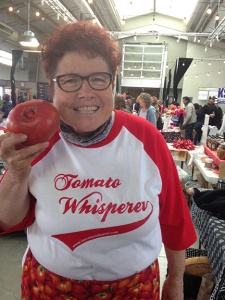
Photo courtesy of http://biologicalthinking.blogspot.com
I always wonder what is that substance on my hands after working with my tomato plants with my bare hands. My hands turn kinda green and eventually brownish. I wash my hands over and over again and the soapy foam on my hands turn yellow and worse, the towel I use to dry my hands gets green stains.
What is this? It is called ‘tomato tar’ and comes from trichomes on the surface of the tomato plant. Trichomes contain chemicals in the form of essential oils that give tomato plants their smell and repels some insects and has another substance called acylsugars. Alcylsugars are part of the defensive system of the tomato by producing a sort of oil that stops insects from wanting to walk on them. This is exactly what gets on our hands and turns them green or even brown if you leave it on your hands long enough. Getting it off is not easy as I mentioned above but I just read a solution to brown tomato hands that I have to try.
I learned the acylsugars are not water soluble. Most soaps are alkaline which turns the soap foam yellow and still keep your hands brown. If we wash our hands in a weak solution of white vinegar and water, really wash our hands with it-no soap and then rinse it off and then wash in soap, our hands should turn human color again! Also use paper towels or a designated towel to dry your hands as the soap residue from our laundry can turn the towels green. I prefer a black or dark brown towel so if there are some stains (they don’t come out) at least I can’t see them.
Lastly I’ve had some luck taking a piece of fresh lemon and rub it over my hands squeezing the juice to make sure my hands are wet. I have to wait about 5 minutes and then rinse in water and then use soap and water and that seems to work too. I know lemons become alkaline when we mix them with water and drink it but pure lemon juice is acidic and works on my hands. It’s been a year since I’ve had tomato hands and I know when I get them, it’s just a short time till I’ll be eating those wonderful tomatoes!

